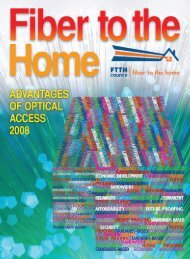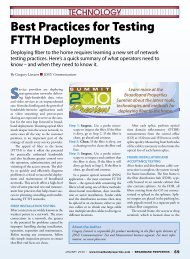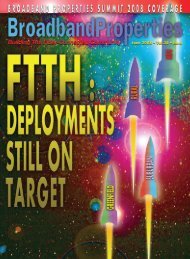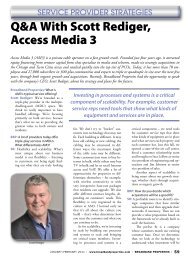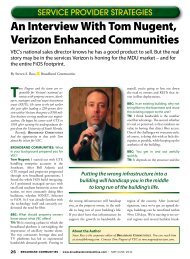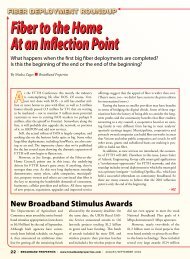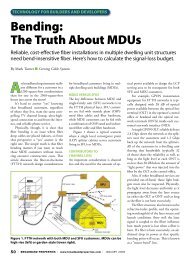bbpmag.com - Broadband Properties
bbpmag.com - Broadband Properties
bbpmag.com - Broadband Properties
Create successful ePaper yourself
Turn your PDF publications into a flip-book with our unique Google optimized e-Paper software.
VATS – the Verizon Advanced Terminal System –<br />
is a preconfigured cabinet with preconnectorized<br />
cable that lets you plug and play tenants as they<br />
sign up for services. We’re finding a 25 percent<br />
cost savings <strong>com</strong>pared to the technology<br />
we had been using.<br />
order services, for instance right after a<br />
resident has signed the lease. There’s a<br />
lounge where you can watch FiOS TV<br />
and surf the Internet at the fastest speeds<br />
because these are services that need to<br />
be experienced. In the store, there are<br />
cubby areas where customers can sit<br />
down and a Verizon representative will<br />
answer questions about the different<br />
FiOS packages available and discuss<br />
current promotions. We love it because<br />
it’s right next to the leasing office, and<br />
we’re going to see if we can negotiate retail<br />
space in other big properties.<br />
At Peter Cooper/Stuyvesant Town,<br />
we have planned many activities out<br />
of the store to make tenants aware that<br />
FiOS is available. We’ve hosted events<br />
such as outdoor concert series and gaming<br />
contests – that’s been a great way to<br />
get tenants engaged – like Guitar Hero<br />
on the Oval. Many of these events help<br />
drive awareness and give people a chance<br />
to experience FiOS.<br />
This year, we’re looking to migrate<br />
to more of a revenue-sharing model. Instead<br />
of paying a one-time fee per living<br />
unit in order to market services on the<br />
property, this model will allow them to<br />
benefit more from greater penetration.<br />
MSOs have been doing this for a while,<br />
but we’ve now built systems to support<br />
this initiative. This would be primarily<br />
in rental space, because there is constant<br />
traffic. As building owners look at this<br />
proposition, they will realize that they<br />
could be a part of the revenue mission<br />
on the property themselves.<br />
Technology Innovations<br />
BBP: One factor that spurred the<br />
deployment of FiOS in MDUs was<br />
the availability of bend-insensitive<br />
fiber. In theory, it was supposed to<br />
make it a lot easier to deploy fiber<br />
inside buildings.<br />
EC: And that’s exactly what’s happening<br />
in practice, particularly in urban<br />
environments like New York City where<br />
space is a <strong>com</strong>modity. With the cable<br />
TV franchises we’ve announced in New<br />
York and Washington, which allow us<br />
to offer FiOS TV, and the one we’re expecting<br />
in Philadelphia, we will be doing<br />
more and more work in high-rise<br />
and mid-rise applications, and bendable<br />
fiber allows for more efficient and costeffective<br />
deployment. In suburban lowrise<br />
apartments we are still using traditional<br />
microduct as well – it’s great to<br />
have choices and some flexibility.<br />
In urban environments, where you<br />
have to bend the fiber around tight turns,<br />
you would degrade or even lose the signal,<br />
and we don’t have that problem anymore.<br />
In addition to getting a better signal,<br />
bend-insensitive fiber is shortening<br />
the installation interval, and it’s much<br />
more aesthetically pleasing. So it’s cutting<br />
the overall cost of implementation.<br />
MDUs represent about a quarter of<br />
the households in Verizon’s wireline <strong>com</strong>munication<br />
territory, so this is clearly an<br />
important business for Verizon. And in<br />
the current economic environment, with<br />
people not being able to buy single-family<br />
homes, a large percentage of our work<br />
is overbuilding and retrofitting of existing<br />
MDU buildings. Because there will<br />
be more rentals than people purchasing<br />
homes, it will present an opportunity to<br />
scale this business for Verizon.<br />
BBP: Beyond bend-insensitive fiber,<br />
have any other new technologies<br />
been particularly important to<br />
deploying fiber in MDUs<br />
EC: Well, there’s VATS – the Verizon<br />
Advanced Terminal System – which is<br />
a preconfigured cabinet with preconnectorized<br />
cable that lets you plug and<br />
play tenants as they sign up for services.<br />
We started using this in 2008, and we’re<br />
finding a 25 percent cost savings <strong>com</strong>pared<br />
to the technology we had been using.<br />
VATS is bringing down installation<br />
time, too.<br />
We’re always looking for ways to<br />
scale the business and bring down capital<br />
costs. We’re also constantly pushing<br />
on the manufacturers to reduce the size<br />
of the ONT [optical network terminal].<br />
We are testing a prototype of one that<br />
looks like a modem and sits on a desk in<br />
the office. Customers have <strong>com</strong>plained<br />
about the big size of the cabinet, and we<br />
like to put one in every living unit – we<br />
prefer to take the signal all the way into<br />
the home when possible – so we worked<br />
with manufacturers to build something<br />
as small as the size of a modem box. The<br />
aesthetics are much better.<br />
We are also using a recessed ONT,<br />
which goes between two-by-fours in the<br />
sheetrock. A lot of property owners love<br />
that, because it’s not taking any space<br />
away from the residents. And we’re putting<br />
rack-mounted ONT units in closets<br />
to serve a whole floor.<br />
BBP: Another problem with deploying<br />
fiber in MDUs has been that<br />
apartment buildings and <strong>com</strong>plexes<br />
are so different, there was no way to<br />
standardize the installations. Is this<br />
still true, or have you found ways<br />
to standardize<br />
EC: We’re getting to the point where we<br />
can handle the different requirements in<br />
a more standardized way. We don’t have<br />
to be as customized anymore. We want<br />
to be able to scale this operation, and our<br />
belief is that by working with the manufacturers<br />
we now have tools that give<br />
us the flexibility we need. Of course,<br />
we still have our engineers review each<br />
building to verify that we have the right<br />
deployment design for that particular<br />
building. The key is in being able to get<br />
similar tools off the shelf to deliver on<br />
that design.<br />
For example, we’ve got multifiber<br />
drops, which let you pull three or five<br />
fibers simultaneously, saving our FiOS<br />
technicians from the rework of pulling<br />
one fiber at a time. I don’t think we’ve<br />
seen the end of what the manufacturers<br />
will create for us. If there’s a mind to<br />
create it, they’ll do it.<br />
44 | BROADBAND PROPERTIES | www.broadbandproperties.<strong>com</strong> | January/February 2009



